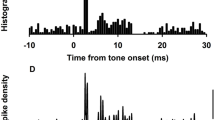Summary
The influence of varying middle ear pressure on the otolith system was investigated in anesthetized cats. Extra-axonal recordings of action potentials were performed in the vestibular nerve fibers and in the neurons in the lateral vestibular nucleus that responded to lateral or anteroposterior steadystate tilt. Positive or negative pressure was applied to the ipsilateral middle ear during the recordings. Seventy-three percent of the fibers and 63% of the neurons responded to changes in the middle ear pressure. These response rates were higher than those previously reported on the units innervating semicircular canals. Findings suggest that the otolith organs are more sensitive to changes in the middle ear pressure than are the semicircular canals. The units responding to lateral tilt were more sensitive to middle ear pressure than those that responded to anteroposterior tilt. Displacement of endolymph caused by pressure changes in the middle ear was considered to have affected the activities of hair cells in otolith organs.
Similar content being viewed by others
References
Armstrong HG, Heim JW (1937) The effect of flight on the middle ear. JAMA 109:417–421
Blanks RHI, Curthoys IS, Markham CH (1972) Planar relationship of semicircular canals in the cat. Am J Physiol 223:55–62
Brwon FM (1971) Vertigo due to increased middle ear pressure: six year experience of aeromedical consultation service. Aerosp Med 42:999–1001
Duensing F, Schaeffer KP (1959) Über die Konvergenz verschiedener labyrintharer Afferenzen auf einzelne Neurone des Vestibulariskerngebiets. Arch Psychiatr Nervenkr 199:345–371
Fernandez C, Goldberg JM (1976) Physiology of peripheral neurons innervating otolith organs of the squirrel monkey. I. Response to static and long-duration centrifugal force. J Neurophysiol 39:970–984
Fernandez C, Goldberg JM (1976) Physiology of peripheral neurons innervating otolith organs of the sqirrel monkey. II. Directional selectivity and force-response relations. J Neurophysiol 39:985–995
Fernandez C, Goldberg JM (1976) Physiology of peripheral neurons innervating otolith organs of the squirrel monkey. III. Response dynamics. J Neurophysiol 39:996–1008
Ingelstedt S, Ivarsson A, Tjernstrom O (1974) Vertigo due to relative overpressure in the middle ear. Acta Otolaryngol 78:1–14
Ito J, Naito Y, Honjo I (1988) The influence of middle ear pressure on the vestibular nerve activity in cats. Acta Otolaryngol (Stockh) (in press)
Lundgren CEG (1965) Alternobaric vertigo — a diving hazard. Br Med J 2:417–421
Author information
Authors and Affiliations
Rights and permissions
About this article
Cite this article
Naito, Y., Ito, J., Tsuji, J. et al. The influence of middle ear pressure on the otolith system in cats. Arch Otorhinolaryngol 245, 321–324 (1988). https://doi.org/10.1007/BF00464641
Received:
Accepted:
Issue Date:
DOI: https://doi.org/10.1007/BF00464641




